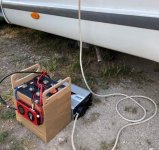Moped
Full Member
- Posts
- 981
- Likes
- 1,137
The other obvious question is that could you use the Jackery as a hook up using a 3pin/euro socket adaptor and then use the Sargent box transformer to charge up the leisure battery?
Without the need to disconnect the 12v circuit if this is required to charge up the leisure battery directly.
And using gas whilst doing this to run the fridge.
And then use the normal van 3 pin sockets to charge up electric bike batteries?
Has this been done by anybody?
Without the need to disconnect the 12v circuit if this is required to charge up the leisure battery directly.
And using gas whilst doing this to run the fridge.
And then use the normal van 3 pin sockets to charge up electric bike batteries?
Has this been done by anybody?

